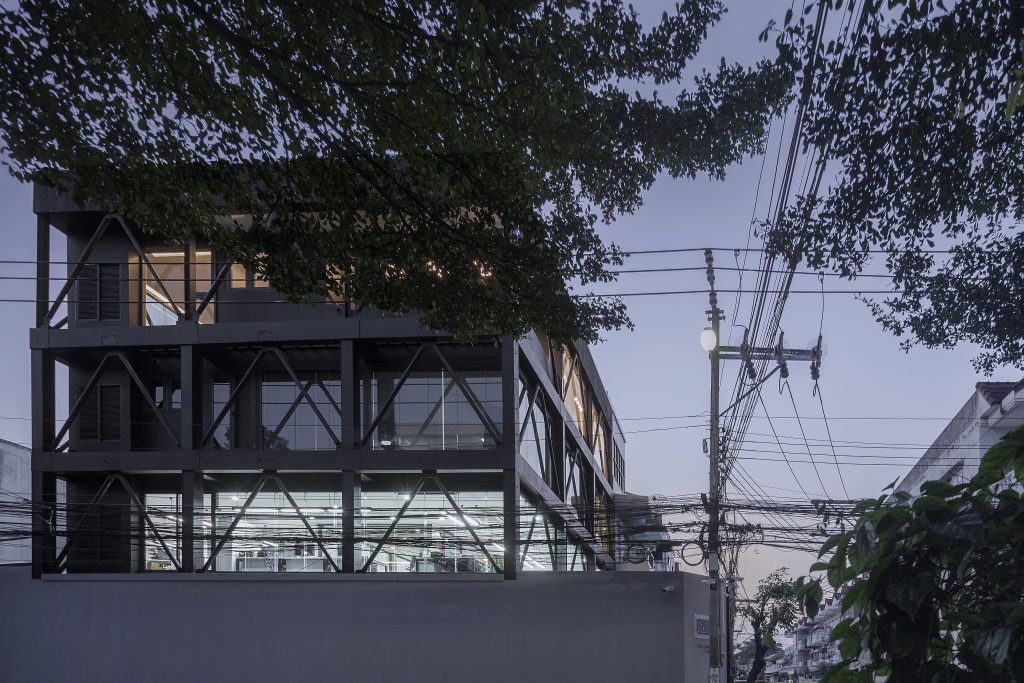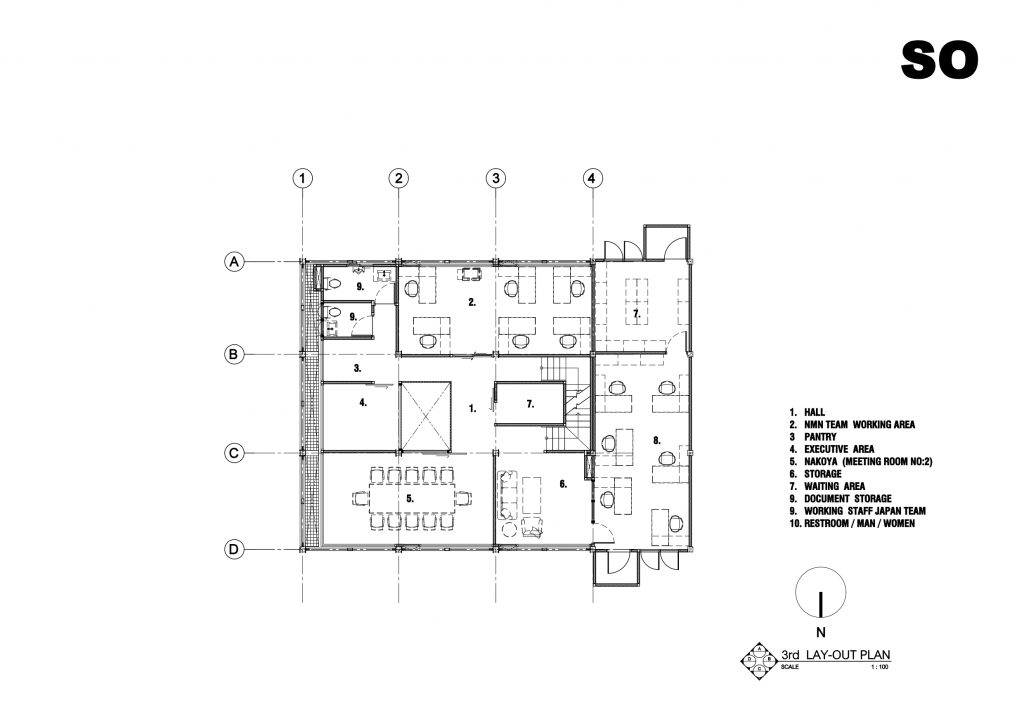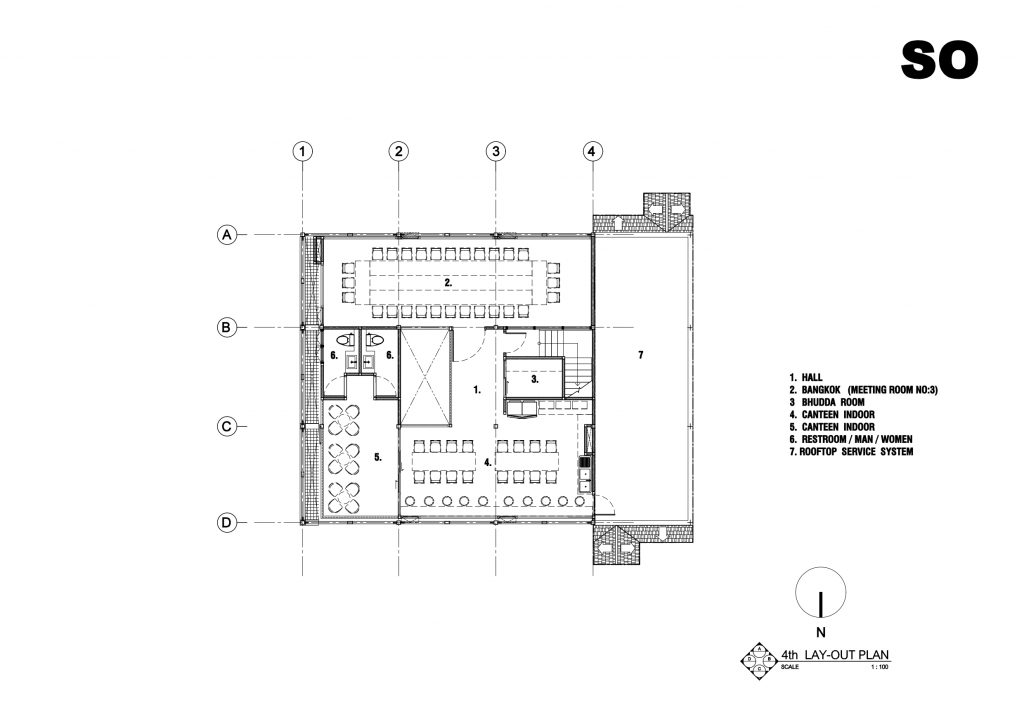SO Architects has refurbished old three-unit townhouses for an engi- neering consultant, using massive space trusses, which maximize the structure’s load-bearing capacity and give the building a distinctive appearance.
Text: Warut Duangkaewkart
Photo Courtesy of SO Architects and Soopakorn Srisakul except as noted

โจทย์ของงานออกแบบสถาปัตยกรรมในหลายๆ ครั้ง เริ่มต้นด้วยความต้องการของผู้ที่ใช้งาน หรือเจ้าของโครงการ ไม่ว่าจะเป็นเรื่องของรูปแบบอาคาร ประโยชน์ใช้สอย ที่นำไปสู่ภาพสุดท้ายในงานสถาปัตยกรรม แต่ในบางกรณีโจทย์ของการออกแบบ ก็เริ่มต้นมาจากสิ่งที่มีอยู่เดิมในพื้นที่ ปัญหาที่พบเจอ จนนำไปสู่ภาพที่แตกต่างออกไป
HD 1 คือผลงานออกแบบของ SO Architects ที่เริ่มต้นโครงการนี้ด้วยการทำความเข้าใจบริบท ซึ่งเป็นหนึ่งในแนวทางการทำงานที่ให้ความสำคัญกับการออกแบบอาคารที่มีความสัมพันธ์กับพื้นที่ สอดคล้องกับเรื่องราวที่เกิดขึ้นเฉพาะในช่วงเวลานั้นๆ ทำให้ผลงานของ SO Architects นั้นมีความหลากหลายในแนวทาง ที่ตอบโจทย์ตามเงื่อนไขของแต่ละโครงการที่แตกต่างกันออกไป

เริ่มจากพื้นที่ตั้งของโครงการนี้ ด้วยความที่ตัวอาคารเป็นการนำทาวน์เฮ้าส์สูง 4 ชั้นเดิม ย่านโชคชัย 4 จำนวน 3 คูหา มารีโนเวทเพื่อให้เป็นอาคารสำนักงานหลังใหม่ของ ‘TRI-EN SOLUTION’ บริษัทวิศวกรรมงานระบบ ที่เป็นสำนักงานตั้งอยู่ที่อาคารนี้อยู่เดิม แต่ด้วยโครงสร้างที่เก่าจึงต้องการให้เกิดการออกแบบรีโนเวทใหม่ เพื่อปรับภาพลักษณ์ของสำนักงานแห่งนี้
เมื่อเริ่มทำความเข้าใจ ศึกษา และวิเคราะห์ข้อมูลต่างๆ จากอาคารเดิม ทำให้พบว่าโครงสร้างของอาคารในหลายๆ ส่วน ทั้งเสา และคานนั้น มีความเสื่อมโทรม และเสียหาย ซึ่งทำให้เสียคุณสมบัติในการรับแรงในเชิงโครงสร้าง ที่ส่งผลต่อการออกแบบเพื่อใช้งานใหม่โดยตรง สิ่งนี้จึงถูกหยิบยกมาเป็นโจทย์หลักในการออกแบบอาคาร HD 1 นี้
“เมื่ออาคารไม่แข็งแรง ด้วยความที่เป็นอาคารคอนกรีตเสริมเหล็ก ในเชิงของวิศวกรรมแล้ว เราจำเป็นที่จะต้องเสริมโครงสร้างเพื่อคอยรับแรง ยึดโยงในหลายๆ ส่วน จึงหนีไม่พ้นโครงสร้างเหล็กที่จะต้องถูกนำเข้ามาใช้ โจทย์ต่อไปคือเราต้องมาดูว่าจะสามารถทำงานต่อได้แบบไหน ด้วยรูปแบบไหน จึงเกิดเป็นกระบวนการทำงานร่วมกับวิศวกรขึ้นมาตั้งแต่ตอนเริ่มต้น” คุณ ณรงค์ โอถาวร ผู้ก่อตั้ง SO Architects บอกเล่าถึงกระบวนการเริ่มต้นในการทำงาน
เริ่มต้นด้วยการแก้ปัญหา สถาปนิกเริ่มต้นด้วยการทุบรื้อผนังปูนเดิมออก พื้นบางส่วน กระเบื้องตกแต่งต่างๆ เพื่อลดน้ำหนักที่โครงสร้างต้องแบกรับ ก่อนที่จะเพิ่มโครงสร้างเหล็กเข้ามาเพื่อช่วยซัพพอร์ตการรับแรงของเสา และคาน ซึ่งในทางวิศกรรมแล้ว จำเป็นที่จะต้องเสริมเหล็กหัวเสา เสริมคานต่างๆ ที่มีความลึกเพื่อช่วยให้รับน้ำหนักของโครงสร้างได้ แต่ในกรณีนี้ผู้ออกแบบไม่ได้มองเพียงการแก้ปัญหาที่เสากับคานเท่านั้น จึงเกิดเป็นรูปแบบที่มองว่า พื้นที่ใช้สอยของแต่ละชั้นนั้นสามารถทำหน้าที่เป็นเสมือน Space Truss ขนาดใหญ่ แทนที่การใช้คานแต่ละเส้นในการรับพื้นแต่ละส่วน เพื่อให้เกิดประสิทธิภาพในการรับแรงได้ดีที่สุด อีกทั้งยังช่วยสร้างให้เกิดเอกลักษณ์แก่ตัวอาคารได้ โครงสร้างเหล็กจึงถูกออกแบบให้แสดงออกมาที่เปลือกนอกของอาคาร ประสาน เชื่อมต่อ เข้ากับเสา และคานที่มีอยู่เดิม จนเกิดเป็นกรอบโครงสร้างอาคารเหล็กที่มองเห็นได้จากภายนอก
ในกระบวนการพัฒนาแบบ การทำงานร่วมกับวิศวกรกลายมาเป็นส่วนสำคัญสำหรับงานออกแบบเปลือกนอกของอาคาร การหาจุดร่วมระหว่างเส้นสายที่พอเหมาะของโครงสร้างเหล็ก กับขนาด และการจัดวางทางวิศวกรรรมจึงถูกพัฒนาไปพร้อมๆ กัน ออกมาเป็นการใช้ Space Truss ที่แม้ว่าจะมีขนาดใหญ่ แต่ด้วยรายละเอียด และการเชื่อมต่อของโครงสร้าง ช่วยให้มีองค์ประกอบที่พอดี ควบคู่ไปกับการคำนวณในการรับแรงต่างๆ ที่ยังคงมีความโปร่ง และตัวอาคารรู้สึกไม่แข็งทื่อจนเกินไป ซึ่งการคำนวณต่างๆ ในส่วนนี้ นอกจากที่จะสร้างให้เกิดตัว Façade ของอาคารแล้ว ยังส่งผลถึงพื้นที่ภายใน ที่สอดคล้องกันไปตามประโยชน์การใช้งานอีกด้วย

พื้นที่ภายในถูกปรับเปลี่ยนให้เกิดช่องว่างเป็นโถงภายในอาคาร ซึ่งนอกจากสร้างพื้นที่ให้ดูโปร่งมากขึ้นแล้ว ยังตอบโจทย์ในเรื่องของการลดภาระของโครงสร้างอีกด้วย ความโปร่งของพื้นที่ภายนั้นนั้น เกิดจากการที่ผู้ออกแบบเลือกใช้ผนังกระจกโดยรอบของอาคาร เพื่อลดน้ำหนักของผนังปูน และช่วยให้เกิดมุมมองไปยังวิวโดยรอบ รวมถึงผนังกระจกถูกนำมาใช้ในการกั้นห้องทำงาน ห้องประชุมต่างๆ ส่วนบริเวณพื้นที่การใช้งานที่จำเป็นต้องมีผนังก็เลือกที่จะใช้อิฐมวลเบา หรือผนังเบา เข้ามาแทนที่วัสดุเดิมของอาคาร ทำให้พื้นที่ภายในอาคารนั้นได้รับแสงธรรมชาติเข้าสู่ตัวอาคาร ช่วยให้มีความโปร่งมากขึ้นสำหรับผู้ใช้งานในพื้นที่นี้ ซึ่งสอดคล้องกับความต้องการของเจ้าของโครงการที่ต้องการให้พื้นที่ทำงานส่วนต่างๆ เชื่อมโยงถึงกัน ไม่ตัดขาดออกจากกัน รวมถึงทางเดิน โถงบันได พื้นที่ส่วนกลางทั้งหมดด้วย
ผังการวางพื้นที่ต่างๆ ยังถูกคิดให้สอดคล้องกับงานระบบที่ทางเจ้าของโครงการนั้นมีความเชี่ยวชาญอยู่แล้ว การที่พื้นที่ใช้สอยทั้งหมดถูกจัดวางเรียงตามผนังด้านนอก เพื่อให้เกิดพื้นที่ภายในที่เป็นส่วนบริการของงานระบบต่างๆ รวมไว้ที่จุดเดียว เช่น เรื่องระบบแอร์ที่นำ Condensing Unit ไปรวมอยู่ด้านบนของอาคาร แทนที่การใช้ Split type แบบทั่วไป ก่อนที่จะเดินระบบลงมากระจายความเย็นไปยังแต่ละชั้น รวมถึงระบบไฟฟ้า และระบบประปา ที่ถูกจัดระเบียบด้วยเช่นกัน

ชื่อของ HD 1 ย่อมาจาก Home Day 1 มาจากการที่เจ้าของโครงการต้องการให้รู้สึกถึงการเริ่มต้นสร้างบริษัทในวันแรก ให้พื้นที่นี้สร้างความรู้สึกให้ผู้ที่ใช้งานเข้ามาแล้วรู้สึกเป็นวันใหม่ที่ดีขึ้นเสมอ เช่นเดียวกับพื้นที่อย่างส่วนอกกำลังกาย และพื้นที่รับประทานอาหารของพนักงาน ที่อยู่ชั้นบนสุดของอาคาร ซึ่งเป็นพื้นที่ที่ถูกออกแบบมาแล้วช่วยสร้างประสบการณ์ใหม่ให้กับพนักงาน เปลี่ยนวิถีชีวิตให้ดีขึ้น มีพื้นที่สำหรับพักผ่อน และสันทนาการมากขึ้นด้วย รวมไปถึงรายละเอียดเล็กน้อยๆ อย่าง สีของผนัง ที่ผู้ออกแบบเลือกใช้สีขาวที่มีเฉดสีฟ้าอ่อนๆ เมื่อถูกแสงกระทบ ให้สอดคล้องไปกับโลโก้ของบริษัท
ท้ายที่สุดแล้ว การเลือกใช้วัสดุในงานออกแบบสถาปัตยกรรมมีอยู่หลายปัจจัย ไม่ใช่แค่วัสดุอย่างเหล็กเพียงอย่างเดียวเท่านั้น รวมไปถึงวัสดุอื่นๆ ที่อาจจะเริ่มต้นจากคุณสมบัติของวัสดุที่เหมาะสม ได้แก่ ความทนทาน น้ำหนัก ผิวสัมผัส ให้เหมาะสมกับการใช้งาน แต่ในอีกมุมหนึ่ง SO Architects มองว่า หากสถาปนิกทำความเข้าใจ และเลือกใช้วัสดุใดวัสดุหนึ่ง เพื่อสร้างให้เกิดภาพลักษณ์ หรือความหมายใหม่กับโครงการนั้นๆ รวมถึงสร้างความเชื่อมโยงให้กับบริบท ที่ไม่ใช่เพียงแค่พื้นที่ สภาพแวดล้อม แต่เป็นบริบทของผู้ใช้งาน เจ้าของโครงการ สิ่งเหล่านี้ก็สามารถช่วยให้วัสดุแสดงออกถึงศักยภาพที่แตกต่างออกไปได้เช่นกัน

Typically, an architectural design brief begins with the requirements of the user or owner. From physical appearance to functions, a brief guides a project to its last step; a finished product that is a work of architecture. There are, however, instances in architectural design in which site-specific factors, such as problems or constraints, might lead to a different outcome.
The HD 1 was created by SO Architects. The studio begins working on the project with knowledge of its context, which is one of the approaches that SO Architects prioritizes. The studio focuses on creating a structure that has a certain relationship and relevance to the location it occupies along with the story that occurs at a specific time. It explains the diversity of SO Architects’ projects, for such an approach allows each work to be tailored to its own particular conditions and needs.

The site is home to the three units of four-story townhouses, which were later turned into the new office building of the system engineering consulting firm ‘TRI-EN SOLUTION.’ The townhouses were formerly used as the company’s office in the past. Nevertheless, due to the buildings’ deteriorating structures, a renovation was implemented to revamp both the company’s workspace and corporate image.
With an effort to comprehend, study, and analyze information obtained from the original building, the design team discovered that a number of structural components, such as the columns and ceiling, are in poor or damaged condition, while their capacity to support structural loads would have a direct impact on the new design and functions. The restriction eventually became one of the project’s primary design criteria.
“When the building lacked sufficient structural capability, engineering-wise, the design of a reinforced concrete structure prompted us to include additional structural elements to support the loads and hold together a number of other components. It was inevitable for us to adopt the use of steel framework structure,” Narong Othavorn, the principal architect of SO Architects, explains the beginning of the design process. “The next challenge is how and in what direction the design can be further developed, which led to this collaborative approach with the engineer.”

The architect begins by eliminating the original concrete walls, portions of the floor, and decorative tiles to lighten the structure’s load. Steel structure is brought in to help support load bearing capacity of the columns and ceiling. To adequately carry the structure’s whole load from an engineering perspective, the capitals of the columns and beams must contain reinforced steel components of suitable depth. The architect searched for the most viable alternatives beyond the columns and beams and adopted a strategy in which the functional spaces on each floor serve as a massive space truss, as opposed to using separate beams to sustain the weight of each floor segment. This maximizes the structure’s load-bearing capacity and gives the building a distinctive appearance. The steel framework was intended to express itself through the building’s façade by intertwining and connecting to the original columns and beams, consequently generating a steel structure that is visible even from the outside.

Involving the engineer as a significant collaborator in the development of the facade’s design entails finding a common ground where the development of the steel structure’s lines and contour, as well as engineering, occurred concurrently. The result is a space truss that, despite its relatively vast size, contains details and elements that interconnect the structure and maintain the required balance. The space truss is engineered in tandem with other calculated load-bearing parts to keep the overall structure open and not overly rigid. The calculations not only rendered the building’s façade but also the interior spaces that correspond with the functional program.
The interior space was modified to create a void whose voluminous presence makes the area more open and spacious while reducing the load that would have otherwise burdened the structure. The architect achieves the openness of the floor space by using glass as the building’s exterior walls to reduce the weight of the concrete wall while exposing the interiors to the outside view.

The glass is also utilized as partitions in workplaces and meeting rooms. In areas requiring solid walls, superblock is used for the construction of walls and partition walls, replacing the original building materials. This introduces the space to more natural light and spaciousness. The result fulfills the owner’s desire for the many components of the office’s functional program, including the walkways, staircases, and all the common rooms, to be interconnected and not completely isolated from one another.
The layout is created with the building’s structural support systems, the project owner’s area of expertise, in mind. The functions are positioned along the external walls, consequently creating an interior space where all system services are centralized. For example, the placement of the condensing unit in the upper portion of the building as opposed to the more common split type allows the system to distribute cool air to each story. Even the placement and installation of electrical and plumbing systems are meticulously planned and calculated.




